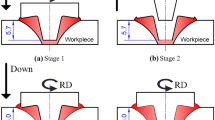Abstract
Adequate heat input provided by the proper combination of friction stir welding (FSW) parameters is critical to sound welding. Optimum parameter setting requires exhaustive trials and extensive experiments, which require considerable time, resources, and cost. This study uses simulation and modelling approaches to generate three significant tool-work heat flux generating interfaces (tool shoulder, lateral and bottom surfaces of the pin). The temperature data was acquired by performing nine experiments on 4 mm thick AA6060-T5 sheets. The effects of significant FSW parameters (Tool Rotational Speed (TRS) and welding speed (WS)) on the heat input were modelled. The calculated heat input rates at the shoulder and pin surfaces (Q1, Q2, and Q3) were numerically estimated. The experimental data was converted into a mathematical model using the response surface method to study the effect of welding parameters on heat input from each of the three surfaces. The analysis of the results showed that among three interfaces, the shoulder provides the most significant heat input due to the immense friction between this surface and the parts to be welded. The interaction between the main factors produced little heat on the three surfaces. The ANOVA test showed that the three models are a good approximation of the results of both experiments and theories.








Similar content being viewed by others
REFERENCES
Emamian, S., Awang, M., Yusof, F., Hussain, P., Meyghani, B., and Zafar, A., The effect of pin profiles and process parameters on temperature and tensile strength in friction stir welding of AL6061 alloy, in The Advances in Joining Technology, Springer, 2019, pp. 15–37. https://doi.org/10.1007/978-981-10-9041-7_2
Gangil, N., Maheshwari, S., and Siddiquee, A.N., Influence of tool pin and shoulder geometries on microstructure of friction stir processed AA6063/SiC composites, Mech. Ind., 2018, vol. 19, no. 2, p. 211. https://doi.org/10.1051/meca/2018010
Asmare, A., Al-Sabur, R., and Messele, E., Experimental investigation of friction stir welding on 6061-T6 aluminum alloy using Taguchi-Based GRA, Metals, 2020, vol. 10, no. 11, p. 1480. https://doi.org/10.3390/met10111480
Liu, X., Yu, Y., Yang, S., and Liu, H., A modified analytical heat source model for numerical simulation of temperature field in friction stir welding, Adv. Mater. Sci. Eng., 2020, vol. 2020, p. 4639382. https://doi.org/10.1155/2020/4639382
Shaik, B., Gowd, G.H., and Durgaprasad, B., Experimental investigations on friction stir welding process to join aluminum alloys, Int. J. Appl. Eng. Res., 2018, vol. 13, no. 15, pp. 12331–12339.
Khalaf, H.I., Al-Sabur, R., Abdullah, M.E., Kubit, A., and Derazkola, H.A., Effects of underwater friction stir welding heat generation on residual stress of AA6068-T6 aluminum alloy, Materials, 2022, vol. 15, no. 6, p. 2223. https://doi.org/10.3390/ma15062223
Siddiquee, A.N., Pandey, S., Abidi, M.H., AlAhmari, A., Khan, N.Z., and Gangil, N., Microstructural characterization and in-process traverse force during friction stir welding of austenitic stainless steel, Proc. Inst. Mech. Eng., Part C, 2020, vol. 234, no. 5, pp. 1031–1043. https://doi.org/10.1177/0954406219888238
Al-Sabur, R., Jassim, A.K., and Messele, E., Real-time monitoring applied to optimize friction stir spot welding joint for AA1230 Al-alloys, Mater. Today: Proc., 2021, vol. 42, pp. 2018–2024. https://doi.org/10.1016/j.matpr.2020.12.253
Zhang, X., Xiao, B., and Ma, Z., A transient thermal model for friction stir weld. Part I: the model, Metall. Mater. Trans. A, 2011, vol. 42, no. 10, pp. 3218–3228. https://doi.org/10.1007/s11661-011-0729-5
Nunes, A., Heat input and temperature distribution in friction stir welding, Month, 1998, pp. 163–172. Tang, W., Guo, X., McClure, J.C., Murr, L.E., and Nunes, A.C., Heat input and temperature distribution in friction stir welding, J. Mater. Process. Manuf. Sci., 1998, vol. 7, no. 2, pp. 163–172.
Song, M. and Kovacevic, R., Heat transfer modelling for both workpiece and tool in the friction stir welding process: a coupled model, Proc. Inst. Mech. Eng., Part B, 2004, vol. 218, no. 1, pp. 17–33. https://doi.org/10.1243/095440504772830174
Song, M. and Kovacevic, R., Thermal modeling of friction stir welding in a moving coordinate system and its validation, Int. J. Mach. Tools Manuf., 2003, vol. 43, no. 6, pp. 605–615. https://doi.org/10.1016/S0890-6955(03)00022-1
Nandan, R., Roy, G., and Debroy, T., Numerical simulation of three-dimensional heat transfer and plastic flow during friction stir welding, Metall. Mater. Trans. A, 2006, vol. 37, no. 4, pp. 1247–1259. https://doi.org/10.1007/s11661-006-1076-9
Su, P., Gerlich, A., North, T., and Bendzsak, G., Energy utilization and generation during friction stir spot welding, Sci. Technol. Weld. Joining, 2006, vol. 11, no. 2, pp. 163–169. https://doi.org/10.1179/174329306X84373
Mishra, S. and DebRoy, T., A heat-transfer and fluid-flow-based model to obtain a specific weld geometry using various combinations of welding variables, J. Appl. Phys., 2005, vol. 98, no. 4, p. 044902. https://doi.org/10.1063/1.2001153
Serier, M., Alazzawi, S., Chikh, A., Berrahou, M., Ahmad, T., Shihab, S.K., and Siddiquee, A.N., Parametric studies of friction stir welding with tool using a vibrating shoulder, Mater. Today: Proc., 2022, vol. 62, pp. 70–76. https://doi.org/10.1016/j.matpr.2022.02.136
Al-Sabur, R., Tensile strength prediction of aluminium alloys welded by FSW using response surface methodology—Comparative review, Mater. Today: Proc., 2021, vol. 45, pp. 4504–4510. https://doi.org/10.1016/j.matpr.2020.12.1001
Verduzco Juárez, J., Dominguez Almaraz, G., García Hernández, R., and Villalón López, J., Effect of modified pin profile and process parameters on the friction stir welding of aluminum alloy 6061-T6, Adv. Mater. Sci. Eng., 2016, vol. 2016, p. 4567940. https://doi.org/10.1155/2016/4567940
Hamilton, C., Dymek, S., and Sommers, A., A thermal model of friction stir welding in aluminum alloys, Int. J. Mach. Tools Manuf., 2008, vol. 48, no. 10, pp. 1120–1130. https://doi.org/10.1016/j.ijmachtools.2008.02.001
Louvet, F. and Delplanque, L., Design of Experiments: The French Touch, Orléans: Experimentique, 2005.
Goupy, J., Pratiquer les plans d’expériences, Dunod, 2005.
Author information
Authors and Affiliations
Corresponding authors
Ethics declarations
The authors declare that they have no conflicts of interest.
About this article
Cite this article
Chikh, A., Serier, M., Al-Sabur, R. et al. Thermal Modeling of Tool-Work Interface during Friction Stir Welding Process. Russ. J. Non-ferrous Metals 63, 690–700 (2022). https://doi.org/10.3103/S1067821222060049
Received:
Revised:
Accepted:
Published:
Issue Date:
DOI: https://doi.org/10.3103/S1067821222060049




